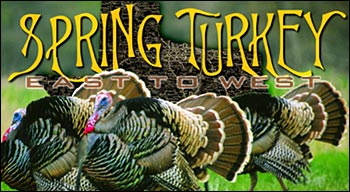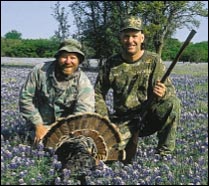
Earning your degree in "tomology"
is a rewarding adventure.
By Larry D. Hodge
About the only thing certain about turkey hunting is that nothing
is certain. That's what makes it so much fun. You never know when
a big tom is going to get up in your face and gobble about how
pretty he is.
By the same token, he's just as likely to turn tail and run or
hang up just out of range. Texas toms can blow up just as fast
as a spring tornado-and leave you just as weak in the knees.
Like I said, hunting them is fun.
Texas has the country's largest population of Rio Grande turkeys,
which range most of the state west of Interstate 45. But Easterns
have been coming on strong where the tall trees grow, with the
result that spring turkey hunting is now allowed in most East
Texas counties. There aren't many birds there compared to the
flocks you'll find in the Edwards Plateau and South Texas, but
hunting big birds in tall timber is an adventure every devoted
turkey hunter should have. It's an exhilarating (and often frustrating)
experience.

Shannon Tompkins, Houston Chronicle outdoor writer and veteran turkey hunter, shows off a trophy Rio Grande tom, taken with Ron
Wood area outfitter Harry Wayne Cloud. Brownwood and Comanche
counties afford some of the finest turkey hunting in the entire
state.
|
I've hunted turkeys on both public and private land from the
Panhandle to deep South Texas and from San Angelo to the Sabine.
Every single hunt has been different. That's another reason turkey
hunting is so much fun: Every tom you meet teaches you something
new. Every mistake you make is an opportunity to learn. I've made
enough mistakes to earn a graduate degree in "tomology,"
but I've managed to collect a few beards as well as an education.
Maybe some of the things I've learned will help you do the same.
Eastern turkeys have the reputation of being more difficult to
hunt than Rio Grandes, being less vocal and more wary. My limited
experience with them seems to bear that out. Hunting on the Moore
Plantation Wildlife Management Area (WMA) in the Sabine National
Forest last spring marked the beginning of my education on Easterns.
Moore Plantation WMA was one of the first to be restocked with
turkeys. However, numbers are still relatively low, and the dense
forest makes hunting difficult. Easterns prefer mature stands
of mixed hardwoods and pines with an open understory. Prescribed
burns conducted regularly and at the right time are necessary
to maintain the habitat to their liking. Unfortunately, the possibility
of smoking populated areas often prevents the burns, and an emphasis
to use burns for timber management rather than wildlife management
also means burns don't always happen when needed, so turkeys may
be thick one year and gone the next. Last year's hotspot may be
a turkey dead zone this year. Always check with the Texas Parks
& Wildife Department biologists in charge of public lands
before making a trip to hunt Easterns.
Locating gobblers by giving crow or owl calls to make them gobble
and then setting up and calling them in works much better on Rio
Grandes than on Easterns. Veteran turkey hunters Charles Foster,
Sr., and Charles Foster, Jr., of Houston use a method to hunt
Easterns that is more reliable. They roost a gobbler at dusk,
then return to hunt him the next morning. However, this is often
difficult to do given the scarcity of turkeys. You have to do
a lot of scouting and listening to catch a gobbler giving that
one gobble at dusk when he flies up to roost.
Once a gobbler is located, says Charles Jr., "You'd better
be there the next morning, set up and ready to call at least half
an hour before he wakes up." Foster says he sets up within
100 yards of the bird, waits until he gobbles, yelps to make him
answer and then yelps sparingly or clucks and purrs after flydown.
Often the tom will not gobble after he's on the ground, so you
must sit still, be patient and watch carefully for that red, white
and blue head moving through the trees. When this method works,
the hunt is usually over within a few minutes after legal shooting
time begins. When it fails, it's a long day in the woods waiting
for dusk to come so you can try to locate another gobbler.
In contrast, hunting Rio Grandes in the turkey-rich Hill Country
or South Texas Brush Country offers nonstop action that begins
before dawn and continues until a bird-or the sun-goes down. Whereas
Easterns have so many trees from which to choose that they can
fly up wherever dark catches them, Rio Grandes often roost in
the same area, or even the same trees, night after night.
Locate a roost, set up in the right spot, and your hunt can be
over before the sun comes up.
Two little words in that last sentence cause trouble far out
of proportion to their size. Choosing the "right spot"
to set up is no easy matter. It's my opinion that 90 percent of
turkey hunting success is in choosing the right set-up, and 90
percent of choosing the right set-up is luck.
It helps to know a little about what's on a turkey's mind when
he wakes up in the morning. First and foremost is always survival.
That's why turkeys won't fly down until it's light enough to see
if there's a predator down there waiting to pounce on them when
they land.
Visibility is a primary key as to where turkeys will fly down.
They prefer to land in an open area that does not offer cover
for predators.
continued
page 1 / page 2
| 
